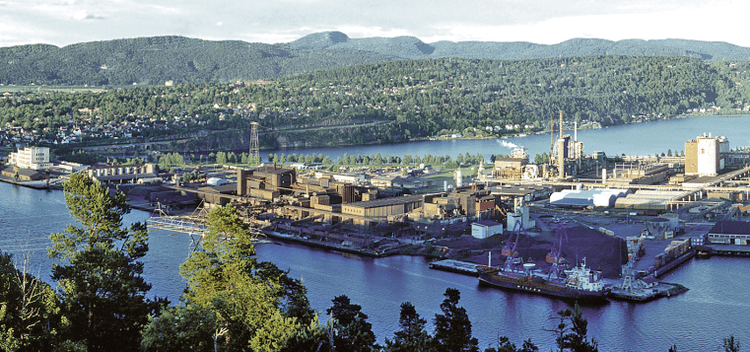Local time Friday 9:24 AM | Administrative centre Porsgrunn Demonym(s) Porsgrunning Population 34,623 (1 Jan 2010) | |
 | ||
Weather 4°C, Wind W at 8 km/h, 63% Humidity Points of interest Porsgrund Porcelain Factory AS, Gea Norvegica Geopark, Vallermyrene leir | ||
Porsgrunn is a city and municipality in Telemark county, Norway. It is part of the traditional region of Grenland. The administrative centre of the municipality is the city of Porsgrunn.
Contents
- Map of Porsgrunn Norway
- Name
- Coat of arms
- History
- Geography
- Industry
- Transportation
- Twin towns Sister cities
- References
Map of Porsgrunn, Norway
The municipality of Porsgrunn was established on 1 January 1838 (see formannskapsdistrikt). The town of Brevik and the rural district of Eidanger were merged into the municipality of Porsgrunn on 1 January 1964.
The conurbation of Porsgrunn and Skien is considered by Statistics Norway to be the seventh-largest city in Norway.
Name
The place is first mentioned in 1576 ("Porsgrund") by the writer Peder Claussøn Friis in his work Concerning the Kingdom of Norway (see the article: Norwegian literature). He writes: "Two and a half miles from the sea, the Skien river flows into the fjord, and that place is called Porsgrund." The name was probably given during medieval times to the then swampy area by the nuns of Gimsøy Abbey, who went here to collect the shrub pors ("Bog Myrtle"), and the Norwegian word grunn meaning "ground". Prior to 1931, the name was spelled "Porsgrund".
Coat-of-arms
The coat of arms is from modern times. They were granted on 16 January 1905. The arms were devised in 1905 when the city needed a new city hall. The silver bend is the small river running through the city. The upper half shows a silver-colored branch of bog myrtle on a red background and is thus a canting symbol. The silver anchor on a blue background symbolizes the importance of the local harbor.
History
Porsgrunn has been an important harbor town in the Grenland area since the late 16th century. In 1653, the Customs House was moved further down the Telemarksvassdraget from Skien to Porsgrunn mainly because industrial waste such as sawdust and mud made the river too shallow to allow boats to go any further up the river. Moving the Custom House to Porsgrunn added to the flourishing harbor activity and Porsgrunn became a thriving market town.
In the 18th century, it was the home of some of Norway's most influential families at the time, such as the Aalls, Cappelens, Løvenskiolds, and Deichmans. Also in this period, Porsgrunn was considered the cultural centre of Norway. On the ecclesiastical side, Porsgrunn was separated from the ancient rural parishes of Eidanger, Solum, and Gjerpen in 1764 to become a prestegjeld with its own minister. Churches within the Porsgrunn prestegjeld include Østre Porsgrunn Church and Vestre Porsgrunn Church. The city was granted limited city status in 1807, but this was expanded to full city status in 1842.
Porsgrunn was once home to Skomvær, the country's largest sailing ship. In 1985, the sculpture Amphitrite, the wave and the sea birds was unveiled in Porsgrunn. The sculpture, which is one of Jørleif Uthaug's best known works, has a nautical theme in honor of Porsgrunn's maritime history.
Geography
Porsgrunn borders the municipalities of Skien and Siljan to the north, Bamble in the west, and Larvik in the east. It is part of a cluster of municipalities in southern Telemark that constitute the Grenland area of Norway. The city is situated near Gunneklevfjord, and at the mouth of the river Telemarksvassdraget or Skien River (Skienselva). The peninsula of Herøya, southeast of the city, was originally an industrial park and has grown into a suburb of Porsgrunn.
Industry
Porsgrunn is an important center of industry and has a long history of heavy industry. Important industries in Porsgrunn include:
Transportation
Transportation links from Porsgrunn:
Twin towns — Sister cities
The following cities are twinned with Porsgrunn:
